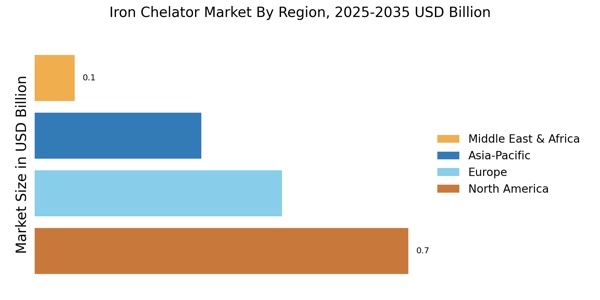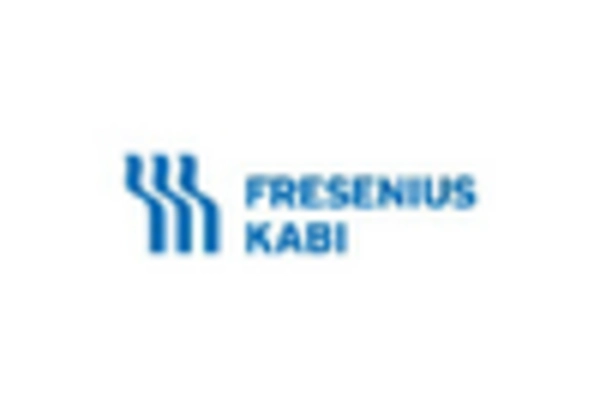Rising Geriatric Population
The demographic shift towards an aging population is likely to have a profound impact on the Iron Chelator Market. Older adults are more susceptible to various health conditions, including iron overload disorders, which necessitate effective management strategies. As the geriatric population continues to expand, the demand for iron chelation therapies is expected to rise correspondingly. According to recent statistics, the proportion of individuals aged 65 and older is projected to increase significantly in the coming years, thereby amplifying the need for specialized treatments. This trend suggests that pharmaceutical companies may focus on developing innovative iron chelators tailored to the unique needs of older patients, further driving growth within the Iron Chelator Market.
Growing Incidence of Chronic Diseases
The increasing incidence of chronic diseases, such as thalassemia and sickle cell disease, is likely to drive the Iron Chelator Market. These conditions often result in iron overload due to frequent blood transfusions, necessitating the use of iron chelators for effective management. As the prevalence of these diseases continues to rise, healthcare providers are expected to seek out effective treatment options to mitigate the associated risks of iron overload. Recent data indicates that the number of patients requiring long-term iron chelation therapy is on the rise, which may lead to an expansion of the Iron Chelator Market. This trend underscores the importance of developing and providing accessible iron chelation therapies to address the needs of affected populations.
Increasing Awareness of Iron Deficiency
The rising awareness regarding iron deficiency and its associated health risks appears to be a pivotal driver for the Iron Chelator Market. As healthcare professionals and patients become more informed about the implications of iron overload and deficiency, the demand for effective treatment options is likely to increase. This awareness is further fueled by educational campaigns and initiatives aimed at promoting better nutritional practices. In recent years, the prevalence of iron deficiency anemia has been reported to affect millions worldwide, leading to a heightened focus on iron chelation therapies. Consequently, the Iron Chelator Market is expected to witness growth as healthcare systems prioritize the management of iron-related disorders, thereby enhancing the availability and accessibility of iron chelators.
Regulatory Support for Iron Chelation Therapies
Regulatory support for iron chelation therapies is emerging as a crucial driver for the Iron Chelator Market. Governments and health authorities are increasingly recognizing the importance of managing iron overload disorders, leading to the establishment of favorable regulatory frameworks. This support may facilitate the approval and commercialization of new iron chelators, thereby enhancing market dynamics. Furthermore, initiatives aimed at improving patient access to these therapies could stimulate demand and encourage pharmaceutical companies to invest in research and development. As regulatory bodies continue to prioritize the management of iron-related health issues, the Iron Chelator Market is likely to benefit from increased innovation and a broader range of treatment options.
Technological Advancements in Drug Delivery Systems
Technological advancements in drug delivery systems are poised to revolutionize the Iron Chelator Market. Innovations such as nanotechnology and targeted delivery mechanisms may enhance the efficacy and safety of iron chelation therapies. These advancements could lead to the development of new formulations that minimize side effects while maximizing therapeutic benefits. For instance, the integration of smart drug delivery systems may allow for controlled release of iron chelators, improving patient compliance and treatment outcomes. As these technologies continue to evolve, they are likely to attract investment and research efforts, thereby propelling the Iron Chelator Market forward. The potential for improved patient experiences and outcomes may further stimulate demand for advanced iron chelation therapies.


















Leave a Comment